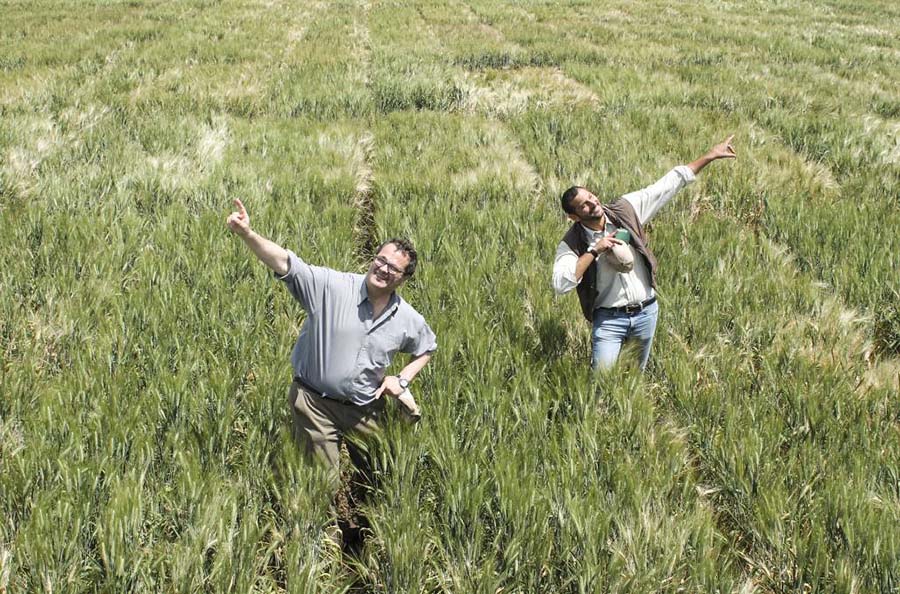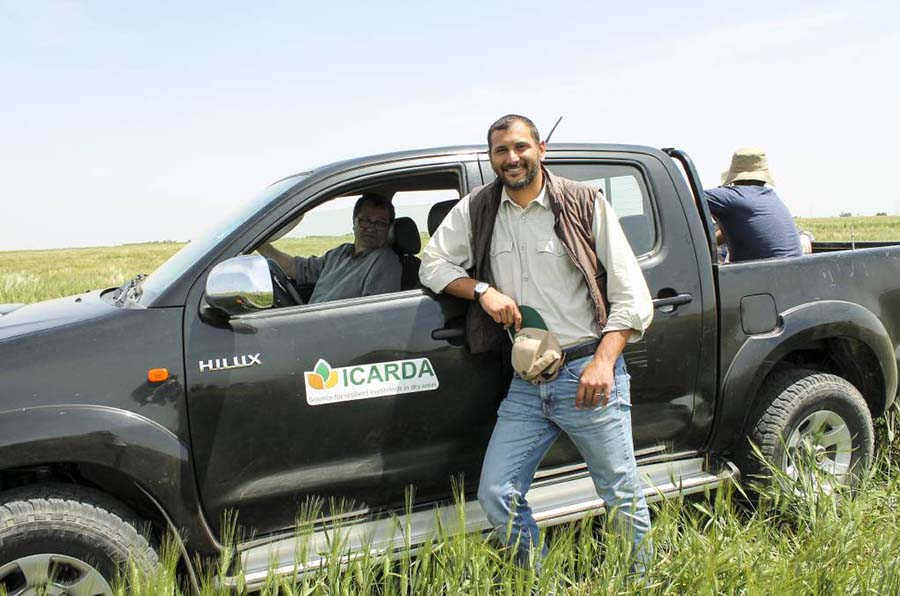A novel panel of genetic markers, adding new hardiness to the hardest of all wheat classes, is predicted to supercharge the performance of Australian durum wheat, particularly in a changing climate, and help push the crop's adaptability into hotter, drier territory.
The research, integrating new sources of genetic tolerance into elite durum wheat (Triticum durum) germplasm is also expected to help Australian growers, and other growers in dry regions of the world, supply increased global demand for the grain as human food and livestock feed.
For example, the 2016-17 season saw a record world harvest of more than 40 million tonnes for the crop, used to make pasta, couscous, bulgur, freekeh, puffed and hot cereals, desserts, pastry filler and some bread types.
Highlighting the potential for crop expansion, in Australia and internationally, the world's second most cultivated wheat (behind common wheat, Triticum aestivum) currently constitutes less than 10 per cent of overall global wheat production.
However, abiotic (non-living) stresses such as heat and drought, which are predicted to rise in a changing climate, pose a major barrier to crop expansion, since they limit areas suitable for growing durum.
In an effort to overcome these constraints, GRDC-invested research has identified and secured new genetic traits showing improved resilience to variable seasonal and climatic conditions.
Cwana origin
Leading the research, senior durum breeder Dr Filippo Bassi at ICARDA says this "next generation" of Australian durum pre-breeding germplasm was drawn from the Central West Asian and North Africa (CWANA) region.

ICARDA's Michael Baum, left, and Filippo Bassi have a blue-sky perspective on the potential for elite durum germplasm to lift the abiotic stress tolerance of Australian durum cultivars. Photo: Clarisa Collis
This is a vast belt stretching from Morocco's Atlas Mountains in the west to Kazakhstan's temperate, dry, northern areas in the east, encompassing Ethiopia's highland high-rainfall areas and Pakistan's fertile irrigated Indus Valley.
"The CWANA represents the most ancient geographical ring where durum has fought terminal stress such as heat and drought, and this has generated wild germplasm rich in sources of tolerance and resistance," Dr Bassi says.
ICARDA researchers exploring the genetic diversity of durum across this region have identified quantitative trait locis (QTLs), or sections of DNA linked to genetic traits, for:
The QTLs for these traits have been converted into genetic markers using Kompetitive allele specific PCR (KASP), a variant of the polymerase chain reaction (PCR) method used in molecular biology to copy specific DNA segments.
Marker selection
The KASP markers were developed for Australian durum breeders to use in marker-assisted selection (MAS) - a process in which plant breeders select traits based on their links to markers.
Dr Bassi says the DNA sections containing the traits for high, stable yield and tolerance to heat and drought were discovered in germplasm sourced from 12 CWANA countries: Azerbaijan, India, Iran, Italy, Lebanon, Mauritania, Morocco, Senegal, Spain, Sudan, Tunisia and Turkey.
The ICARDA team was able to access two sets of genetic material and accompanying data, provided by these collaborating countries.
This genetic material was identified through the GRDC-invested Focused Identification of Germplasm Strategy (FIGS) program.
The new elite durum lines developed from this genetic material, and subsequently crossed with Australian durum cultivars, are being delivered to Australia through the (CIMMYT Australia ICARDA Germplasm Evaluation) CAIGE project - Australia's portal to international germplasm and its pre-breeding programs.
Dr Bassi says the lines will be provided, complete with trait-indicative QTLs and KASP markers, for testing in Australian trials and, ultimately, for use by this country's durum breeding community.
Pre-breeding
Making the transfer of these QTLs into Australian durum cultivars possible was a dedicated plant pre-breeding program at ICARDA as part of the five-year GRDC-invested project.

Signs ready to be used to separate the different generations of plant crosses in the durum wheat breeding program at ICARDA's Marchouch research station. Photo: Clarisa Collis
Since identifying the resilient alleles (variant gene forms), researchers have created 157 durum plant crosses, which are currently at different stages of segregation - a process needed to ensure that each parent plant only passes the targeted traits to its offspring.
Of these plant crosses, initially grown in the field and later in the glasshouse at ICARDA's Marchouch research station near Rabat, Morocco, 57 crosses have reached F4 and F5 generations.
At these generational stages of development, genetic variability is mostly exhausted, meaning the plant crosses are largely homozygous, so subsequent plant generations inherit the QTLs or DNA regions containing the improved traits.
Dr Bassi says 24 of these F4 plant populations have already been tested for the alleles conferring heat and drought tolerance using marker-assisted selection (MAS).
"It is possible to see how the plant populations vary in terms of the total number of potentially useful alleles that each population carries," Dr Bassi says.
"And within each plant population, some individual plants appear to be superior."
The remaining 33 populations of F4 and F5 generation plants will also be tested using MAS principles to help isolate the best-performing individual plants in the subsequent F6 generation.
ICARDA researchers then plan to ship this final selection of elite crosses, contained in packets of seed, to Australia through the CAIGE program in October this year.
Caige trials
Some of the elite germplasm developed, which Dr Bassi likens to a hybrid race car integrating the best components of Ferrari, Lamborghini and Maserati, has already been 'road-tested' under Australian conditions.

Dr Filippo Bassi likens the elite germplasm developed for Australian researchers to a hybrid race car. Photo: Clarisa Collis
He says the GRDC-invested project has singled out the four best plant lines, based on high yield stability, for advanced testing at Australian trial sites through the 2019-20 CAIGE trial program. These trials were sown in May.
Australian durum trials were added to the CAIGE program in 2016 and this growing season, it comprises seven sites across the northern and southern durum growing regions.
The 2019 trials at Sunville, North Star, Tamworth and Breeza in New South Wales; Roseworthy and Kapunda in South Australia; and Kaniva in Victoria are being run in collaboration with the University of Adelaide, NSW Department of Primary Industries, Australian Grain Technologies and S&W Seed Company.
Quality lift
Dr Bassi says the research project has also highlighted the potential for ICARDA germplasm to lift the grain kernel size of Australian durum varieties by up to a third.
This was the finding of analysis comparing the quality of durum grain yielded by Australian cultivars, particularly the Jandaroi (PBR) variety known for its large kernel size, with germplasm sourced from Canada, CIMMYT, Italy and ICARDA.
"Australian plant breeders selecting for kernel size from the CAIGE trials can improve the grain quality of Australian durum cultivars," Dr Bassi says.
ICARDA
Established in 1975, ICARDA is an international R&D organisation that aims to improve food, nutritional and water security, lift environmental health and reduce poverty in dry areas of the world facing climate challenges.
*NOTE: Clarisa Collis travelled to Morocco, in North Africa, with assistance from the Crawford Fund, as the 2018 winner of the Crawford Fund Food Security Journalism Award.
More information: Filippo Bassi, ICARDA, f.bassi@cgiar.org

























































